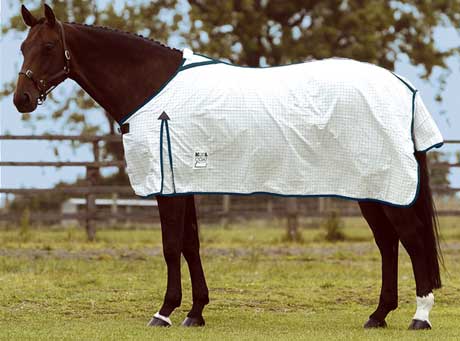White Fly Sheets Are Best for Your Horse
New research indicates that biting flies are more attracted by darker colors.
 Tabanid flies are bloodsuckers (the females) whose bits are extremely painful. They range from the small deer flies to the inch-long dive-bombing deer flies that strike fear in the hearts of both horse and human alike. These flies actually slice a chunk of flesh from the horse when they bite, and may bite multiple times.
Tabanid flies are bloodsuckers (the females) whose bits are extremely painful. They range from the small deer flies to the inch-long dive-bombing deer flies that strike fear in the hearts of both horse and human alike. These flies actually slice a chunk of flesh from the horse when they bite, and may bite multiple times.
A Hungarian study recently released showed that tabanids are primarily attracted by reflected polarized light from black and brown coats, a phenomenon called positive polarotaxis. They found the flies to be much less attracted to white horses. White sheets may therefore help your dark horses from tabanids, although they could still zero in on the head and neck.
Fly Sheet Choices. When choosing a flysheet, remember that a PVC-coated material, like Textilene, will likely hold up better for turnout and rough play. Fortunately, the days of ultra-stiff PVC sheets are mostly gone. They still don’t sit quite as close to the horse as a soft mesh sheet, but they are more durable and less likely to snag.
Fit is paramount, of course, so be sure you find out how the manufacturer measures. Most go from the center of the tail to the center of the chest. Shoulder gussets and surcingles are necessities, and we find that leg straps definitely help to keep the sheet in place. Look for elastic detachable leg straps.
For the horse’s chest, choose a sheet that won’t gap or sag. A hook-and-loop or Velcro-type closure under the buckles here can help.
Fly masks, fly boots, bellybands and neck covers help, too, of course, but don’t go overboard. You need to be careful not to make your horse too hot out in the sun. On very hot days, just fly spray may be the better option.
Reference: Horse Journal, April 2010.
Tabanid Control. Like mosquitoes and many other flies, female tabanids seek out areas of high moisture to lay their eggs. Pond edges are particularly attractive, as is dense vegetation with moist undergrowth. The larvae are as aggressive and vicious as the adults, feeding on things as large as snails or earthworms. Clearing underbrush, regular mowing, good drainage around watering locations and not pasturing close to natural bodies of water will help decrease risk.
Reference: Horse Journal, April 2010.


